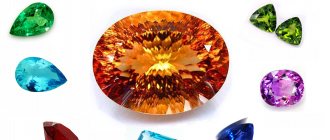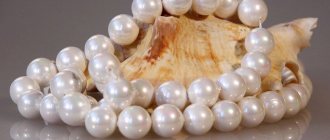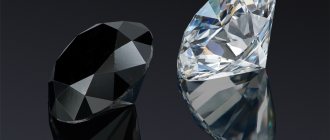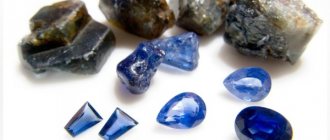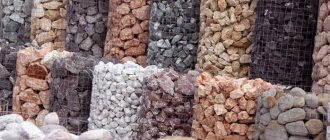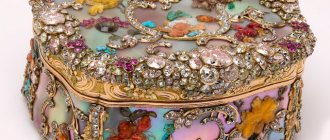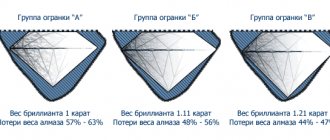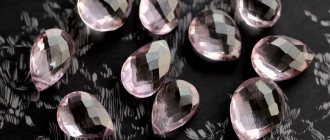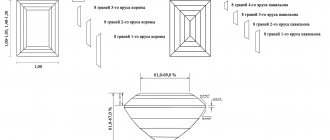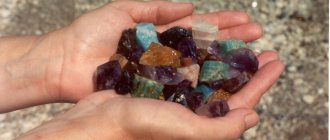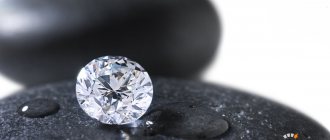This article discusses the terminology of precious stones, and also provides the main classifications
In the photo: the color palette of spinel, which is gaining popularity in Russia
This article discusses the main criteria by which the category of precious stones is distinguished. The names of terms such as jewelry, ornamental, semi-precious, colored and precious stones, and semi-precious stones are explained.
Various classifications with types and names are given:
- - classification by K. Kluge;
- - classification of G. Gurich;
- - classification by M. Bauer - A.E. Fersman;
- - classification by V.I. Sobolevsky;
- - classification by E.Ya. Kievlenko;
- -industrial classification of natural jewelry and ornamental stones of VNIIyuvelirprom;
- - classification E.P. Melnikova.
Gemstone concept. Features of terminology
We have all heard about the existence of a special category of precious stones. Let's try to figure out which ones are considered precious. “Rocks” usually refer to minerals and/or rocks formed in nature without human intervention. And in order to understand what belongs to precious stones and what does not, you need to know the definition of the criteria for “jewelry” in a general sense or in a legal sense (as far as Russia is concerned).
What stones are considered precious? There is no generally accepted definition of the concept of “gemstone” today. In a general sense, this category includes only those natural stones that satisfy three main criteria: beauty, rarity and durability.
The beauty of a specimen is determined by its color, shine, play, as well as other optical properties. It is beauty that determines a person’s desire to become the owner of a stone or jewelry with it.
Rarity (or uniqueness) is determined by the prevalence of a given mineral in nature. Different varieties of minerals can be expensive due to the fact that they are very difficult to find and extract in nature.
Durability depends on its strength. Strength (wear resistance) is affected by the hardness, fragility, cleavage and other properties of the stone.
The consequence of the above criteria is the high cost of all types of precious stones.
But what kind of precious stones are in the legal sense is explained by the already existing Russian legislation. What kind of precious stones are there? The Law of the Russian Federation “On Precious Metals and Precious Stones” provides a list of names: natural diamonds, emeralds, rubies, sapphires and alexandrites, as well as natural pearls in raw (natural) and processed form. Unique amber formations are equated to precious stones in the manner established by the Government of the Russian Federation. Apart from this list with the names of precious stones, the law does not provide any additional definitions or criteria for the quality of these stones. Obviously, this list includes the most popular precious stones (in a general sense), the circulation of which needs to be controlled by the state.
Gemologists consider the concept of precious stones to be broader than just a list of names allocated by law. The high (“expensive”) price of any stone is primarily associated with its high quality characteristics and the rarity of a particular stone at a given time, and not just with its name. Further we will consider the concept of precious stones only in a general sense, and not in a narrow legal sense.
In addition to the concept of “gemstone,” there are other terms that refer to natural stones used in jewelry or stone cutting. Let's look at their diversity.
Jewelry stones are a term applied to any minerals, rocks and mineral aggregates that are highly decorative, wear-resistant, and used in jewelry (sapphire, topaz, heliodor, etc.).
Ornamental stones are rocks, minerals and mineral aggregates suitable for the manufacture of mosaics, objects of decorative and applied art, small plastic arts and jewelry and haberdashery (jasper, obsidian, etc.). They are usually translucent and opaque.
Semi-precious stones is the name of an outdated term that is not recommended for use by gemologists (but is still actively used in Russian trade and is found in legal documents). Initially, this term was used to describe jewelry stones that, for some reason, usually fell short of the “precious” level: they were not as rare, beautiful, or strong enough, and as a result, not as expensive. Nowadays, the use of this term is considered incorrect, since the prefix “semi-” discredits the stone in the eyes of the consumer, hinting at some inferiority of jewelry properties and supposedly its cheapness. But, for example, such stones from the “semi-precious” list as red spinels, Paraiba tourmalines or demantoids, with high quality, can have a cost per carat that is significantly higher than that of representatives from the group of precious stones. Therefore, to describe stones that previously belonged to a type from the list of semi-precious stones, it is recommended to use the term “jewelry stone”.
CHOOSE A STONE IN THE CATALOG
In the photo: emeralds from Colombia. Emeralds belong to the category of precious stones both in the general sense and in the legal sense (according to Russian legislation)
In a general sense, there are no clear boundaries between precious, jewelry and ornamental stones. Often these terms are used as synonyms; there are also various intermediate groups, for example, jewelry and semi-precious stones. The whole variety of minerals used in jewelry and stone cutting can also be designated by the Russian word “gems,” which was introduced into use by Academician A.E. Fersman. Abroad, all natural inserts used in jewelry are called “gemstones,” which are often divided into two main types: diamonds and colored stones (all varieties except diamonds). In Russian literature, the term “noble” is also found, combining precious and decorative (ornamental) stones.
Currently, several classifications of precious stones, compiled by different scientists at different times, are widely known. Most of these classifications are based on the principles of distributing stones according to their value and purpose. Typically, classifications present a rating of popular gemstones in the form of tables, in which the list of names is in descending order of their value (real value). Varieties of precious and “semi-precious” stones in the form of lists are divided into various groups, subgroups, classes and orders.
Stone-on-Obi
print version
The center of the Kamensky district, the city of Kamen-on-Obi, is located 208 km northwest of Barnaul.
Driving through modern Kamen-on-Obi, it is quite difficult to get an idea of the former greatness of this large trading village, later, the city in which all trade of the northern part of Altai was concentrated. Central street named after Lenin still preserved elements of the architecture of the last century, primarily in the current building of the museum - the former Vinokurov mansion . A walk around the city and a visit to the local history museum will take no more than 1.5-2 hours.
Story
The village of Kamen was first mentioned in written sources in 1751. Gradually, its advantageous position on a large river surrounded by numerous villages turned Kamen into a center of agricultural production and intra-Siberian trade. Since 1886, Kamen has been a large merchant village. Thanks to the presence of the pier, Kamen became a center for buying and shipping wheat, and at the beginning of the 20th century. and butter . Altai was one of the few regions that did not suffer from the wave of famine and cholera epidemic of those years. It was here that Siberian steamers and traders bought wheat and transported it along the Ob River to the north, from where the grain arrived by rail to Yekaterinburg and other cities of the Urals. In Kamen, local entrepreneurs traded wheat, primarily the Vinokurovs and Falkovs , as well as steamship operators and traders from Barnaul, Novonikolaevsk, Tomsk, and Tyumen. Danish companies , Knudsen, Irgensen, Martensen and others bought oil and sold separators, equipment for oil factories, and agricultural machinery. At the beginning of the 20th century. Trade quickly developed in Kamen, thanks to which the village gradually transformed into a city. Branches of large trading companies appeared here. In 1912, the village ranked 4th in the Tomsk province in terms of trade turnover, after Tomsk, Novonikolaevsk and Barnaul. Industry was poorly developed, with the exception of flour milling. In 1915, Kamen was given the status of a city, and, oddly enough, its growth slowed down from that time on. During the First World War, the Altai (Novonikolaevsk - Barnaul - Semipalatinsk) and Kulundinskaya (Tatar - Slavgorod) railways were built, which reduced the importance of water transport. In addition, in 1916 there was a big fire, during which 100 houses and 25 commercial premises burned down. Since 1933, the city has had its modern name - Kamen-on-Obi. The name of the city has a literal explanation: the city is named so because of the emergence of a spur of the Salair Ridge, . Bedrock outcrops can be seen in Melnichi Lane .
Walk around the city
Modern Lenin Street (formerly Main Street) is, without a doubt, part of the old city; it stretches parallel to the Ob River for 3 km. Several beautiful red brick houses from the last century will attract your attention. At the beginning of the street, behind the stadium, on a hill, there is an abandoned Epiphany Church (consecrated in 1902). Zorin, Pudovkin, Simonin, Chaigin contributed a lot of money to the construction and arrangement of a stone church on the site of a dilapidated wooden one . Vinokurov ordered a bell weighing 61 pounds in Tomsk and delivered it to Kamen along the river; he, along with other merchants, paid for the labor of the builders. The temple was based on an exemplary design in the pseudo-Russian style, with elements of ancient Russian religious architecture. In the 1930s The crosses were removed from the temple, and a distillery was located inside.
In the building of the mansion of the merchant A.S. Khomutov (Lenin, 18), next to the church, today there is a medical school. This is a two-story brick house with a basement. The façade is decorated with white brick ornaments. The beam openings of the first floor are inscribed in shallow niches. In general, the building is eclectic, elements of classicism are used. At house number 49 on Lenin Street there is the Kamensk State Museum of Local Lore . The city museum is located in a magnificent mansion in the neoclassical style of the Vinokurov merchants. Once upon a time there were merchant shops here on the ground floor, and living quarters with tall semi-oval windows on the second floor. The halls have preserved beautiful cornices and lampshades with molded floral ornaments. Pay attention to the size of this house, the prototype of a family fortress. Step into the courtyard to imagine the influence of this rich and noble Kamensk family.
Today, in addition to the museum, the Vinokurovsky mansion houses an art gallery of local artists, a trading house, and a cafe. Opposite the local history museum is the Park of Culture . At the intersection of Lenin (house No. 66) and Komsomolskaya streets there is a beautiful two-story brick house of the merchant Pudovkin with a rounded corner. Its architecture contains elements of early century Art Nouveau. On the second floor there are twisted wrought iron balconies and decorative elements. Adjacent to the northern part of the building is a single-storey extension with Art Nouveau doors. The facades are topped with stepped attics decorated with stone ornaments. If you turn the corner at this point and walk a little along the street perpendicular to Lenin Street, you will come out to the Ob River.
On Lenin Street, 78, there is the main building of the estate of the merchant Zorin (now a pedagogical school), also built in the eclectic style of the early 20th century. This is a two-story brick building of a cubic shape. On the second floor of the central facade there is a beautiful wrought-iron balcony; the windows are decorated with white brick ornaments. In addition to the fortified mansions of Lenin Street, in Kamen-on-Obi there is a house in which in 1929-1930. lived Yu. V. Kondratyuk (Lenin, 80). This is a large log house from the early 20th century. Yu. V. Kondratyuk (real name Alexander Ignatievich Shargei , 1897-1941) is the author of works on the main problems of the theory of astronautics, the author of the book “The Conquest of Interplanetary Spaces” (1929). Calculations of the trajectory of the flight to the Moon made by Kondratyuk were used when sending the first American astronauts. In the 1920-1930s. he supervised the work on mechanization of grain barns in Biysk, Rubtsovsk, Pospelikha. In 1930, according to his own design, Kondratyuk built a log granary next to the house for 10 thousand tons of grain, the so-called “Mastodon”, of an original design - partially preserved to this day. A memorial plaque was installed on the house of Yu. V. Kondratyuk. The fate of this man is mysterious, since no one knows exactly where and under what circumstances his life ended during the Great Patriotic War.
Another famous resident of Kamen-on-Obi is director and People’s Artist of the USSR I. M. Pyryev (1901-1968). He was born and lived until 1916 in a small one-story wooden house on Lenin, 222.
From Kamen-on-Ob the roads diverge.
One of them along the left bank of the Novosibirsk reservoir leads to Novosibirsk. Another road, skirting the Novosibirsk reservoir, passes among the fields through the village. Krutikha (24 km from Kamen-na-Obi), and then turns south along the valley of the Burla River, in the direction of the villages of Pankrushikha (56 km from the village of Krutikha) and Khabary (62 km from the village of Pankrushikha). Here the route passes through one of the ribbon forests; along the road there are small lakes located in hollows. Date of publication: 04/26/2010 Date of modification: 04/26/2010 Date of publication: 10/13/2019 Date of modification: 10/13/2019
Classification of precious and semi-precious stones by Carl Kluge
In 1860, the German scientist Karl Emil Kluge created one of the first scientifically based classifications of precious and semi-precious stones. The first group was called “true precious minerals” and included stones of the first, second and third classes, and the second group was called “standard precious minerals”, which included stones of the fourth and fifth classes. In classes IV and V of his classification, K. Kluge placed a list of names that he classified as semi-precious stones.
I. Diamond, corundum, chrysoberyl and spinel. II. Zircon, beryl, topaz, tourmaline, garnet, precious opal. III. Cordierite, vesuvianite, peridote, axinite, kyanite, staurolite, andalusite, chiastolite, epidote and turquoise. IV. Quartz (amethyst, rock crystal, rose quartz, aventurine), chalcedony (agate, carnelian, plasma, heliotrope, cacholong, jasper and regular hydrophane), feldspars (adularia, amazonite, labradorite), obsidian, lapis lazuli, hauin, hypersthene, diopside , fluorite, amber. V. Jadeite, jade, serpentine, agalmatolite, bronzite, satin spar, marble, selenite, alabaster, malachite, pyrite, rhodochrosite, hematite, prehnite, nepheline, lepidolite, etc.
Classification of precious stones by value G. Gurich
In 1902, the German professor of mineralogy Georg Gürich presented his classification of precious stones, similar to the classification of K. Kluge.
Transparent minerals with high optical characteristics, which were used in jewelry, were combined by G. Gurich in the list of precious stones of the first kind. The list of semi-precious stones was highlighted separately. The group of stones of the second type (colored stones) included fine-grained crystalline aggregates and minerals in an amorphous state.
G. Gurich divided all precious stones according to their value into five classes. The most expensive gems started this list.
Precious stones of the first (I) class: diamond, corundum, chrysoberyl and spinel. II. Zircon, beryl, topaz, tourmaline and garnet, as well as noble opal from the group of colored stones. III. Cordierite, peridot, kyanite and other precious stones, in addition to turquoise from the group of colored stones. IV. Such “semi-precious” stones as quartz, feldspar, fluorite. And from the group of colored stones: aventurine, cat's eye, chalcedony, opal, obsidian, lapis lazuli and amber. V. Such “colored stones” as hematite, nepheline, jade, jet, serpentine, alabaster, malachite, etc.
The photo shows very expensive large “semi-precious” stones: untreated yellow sapphires (15.29 and 37.28 carats), spessartine garnet (22.40 carats) and tsavorite garnet (29.16 carats)
Popular semi-precious stones: list and photos
Jewelry with semi-precious stones is the most popular category of jewelry. Women's silver bracelets with amethysts, necklaces with topaz, pendants with opals, crosses with garnets, rings with spinel - the catalog of semi-precious stones can be continued endlessly. We have collected only the most popular of them.
Agate
A unique mineral with a layered structure and banded color distribution. Agate is presented in the entire palette: white semi-precious stones, gray, blue, yellow and other shades. Particularly popular is the black semi-precious stone - a strong amulet against negative influences.
Depending on the cut in the picture, gemologists distinguish several varieties of the mineral: Brazilian, moss, iridescent, landscape. Some types of gems have received their own name: black agate is called onyx. Thus, a ring with black agate is an ideal men's accessory.
Noble beryl
This is a green semi-precious stone, the younger brother of emerald. Even during the times of ancient civilizations, beryl was highly valued for its magical and healing properties. It is believed that beryl has incredible energy and is capable of healing and healing wounds. Beryl can have other shades. For example, the blue semi-precious stone of the beryl group - aquamarine - is also highly valued in jewelry.
Pomegranate
A red semi-precious stone that is highly valued in jewelry. Its popularity is so high that it is often classified as a precious gem. The scarlet and rich mineral has symbolized power and might since the Middle Ages. At the same time, garnet can be green (andradite) and orange (spessartine).
The most famous variety of garnet, pyrope, has a rich red color. It is pyrope that craftsmen use to create popular jewelry.
Quartz
The most common mineral in the world. More than 12% of the world's minerals are quartz. There are dozens of its varieties and hundreds of shades, which in no way diminishes its cost and popularity. Common types of semi-precious stones that belong to the quartz group:
- citrine is a yellow semi-precious stone;
- aventurine;
- rauchtopaz is a brown semi-precious stone;
- morion;
- amethyst is a semi-precious stone of lilac color;
- onyx.
Rose quartz is also very popular. It is called a symbol of love, because its energy helps to find a soul mate and strengthen the bond between lovers.
Opal
Semi-precious mineraloid with variable water content. The ancient Romans called it a kaleidoscopic mineral because it had the same shades as rubies, emeralds, sapphires, topazes, and amethysts. The Roman Emperor Constantine was the first to talk about the magical properties of opal: he called it the protector of power and strength.
High-quality minerals are often given unusual cuts to maximize the design. The standard cut for opal is cabochon.
Topaz
A blue semi-precious stone that is often called the November mineral. Topaz can be found in other shades, for example, a yellow gem is popular. It is a transparent mineral with a characteristic glassy luster, which is why it is often compared to precious gems. Topaz is called a symbol of friendship and sincerity; it is given to young people as a protective talisman.
Tourmaline
This semi-precious stone surpasses other minerals in the variety of shades presented. Tourmalines are distinguished not only by a wide range of colors, but also by their crystal structure. The following tourmalines are found in jewelry: elbaite, dravite, uvite, scherl. There are also unique polychrome tourmalines, that is, multi-colored minerals. In one polychrome tourmaline, two or three different shades can be seen with the naked eye.
Chrysolite
A unique greenish stone that resembles spring grass. Earrings with peridot are a wonderful spring accessory that will give you mood and inspiration. Olive and golden minerals are also found. Even the name itself is translated from ancient Greek as “golden stone”. The second name is peridot.
Spinel
A semi-precious mineral with an impressive range of shades. Often, when people talk about spinel, they think of a red semi-precious stone. However, in Ukraine, blue spinel, also called cobalt, is more popular. These are beautiful and deep blue or neon translucent colors. Samples of a translucent blue shade are valued higher.
Amber
Amber products are among the most popular in Ukraine. Our ancestors also learned how to process “golden stone” and create unique jewelry. An amber necklace has long become a mandatory attribute of the national costume. The most famous amber deposit is Volynskoe, which is more than 2 billion years old.
Groups of precious stones according to the classification of M. Bauer - A.E. Fersman
In 1896, German mineralogist Dr. Max Bauer proposed a new classification of gemstone types. It was popular among mineralogists and jewelers for a long time. Later, M. Bauer’s classification was supplemented by A.E. Fersman. Jewelry and ornamental stones are divided into three groups: The first group (category) - precious stones (gems); The second group is ornamental (colored stones); The third group is organogenic precious stones.
Within the groups, the entire list of precious and “semi-precious” stones is divided into orders according to their value. Group I included mainly transparent, colorless or beautifully colored precious stones and some translucent colored stones used in faceted form. Group II includes a number of minerals and rocks suitable for cabochoning and various crafts. Below is the classification of M. Bauer - A.E. Fersman.
I. Precious stones (gems): 1st order: diamond, ruby, sapphire, emerald, alexandrite, noble spinel, euclase. 2nd order: topaz, aquamarine, beryl, red tourmaline, demantoid, blood amethyst, almandine, uvarovite, jadeite, noble opal, zircon. 3rd order: 1. Garnet, cordierite, kyanite, epidote, dioptase, turquoise, variscite, green tourmaline; 2. Rock crystal, smoky quartz, light amethyst, chalcedony, agate, carnelian, heliotrope, chrysoprase, praseme, semi-opal; 3. Sunstone, moonstone, labradorite, nepheline, sodalite, obsidian, titanite, benitoite, prehnite, andalusite, diopside, scapolite, thomsonite; 4. Hematite, pyrite, cassiterite, quartz with gold; II. Ornamental (colored stones): 1st order: jade, lapis lazuli, glaucolite, sodalite, amazonite, Labradorite, rhodonite, azurite, malachite, aventurine, quartzite, rock crystal, smoky quartz, agate and its varieties, jasper, vesuvian, rose quartz, written granite. 2nd order: lepidolite, fuchsite slate, serpentine, agalmatolite, steatite, selenite, obsidian, marble onyx, datolite, fluorite, halite, graphite, lapis lazuli, smithsonite, zoisite. 3rd order: gypsum, porphyry and partially decorative material - breccias, confluent quartzites, etc. III. Precious stones are organogenic: pearls, coral, amber, jet.
This classification was used for a long time in the USSR and abroad. But it has a number of shortcomings. For example, some minerals are simultaneously classified into different orders (rock crystal, agate, smoky quartz, lapis lazuli, etc.). Also, sometimes group mineralogical names are given simultaneously with the names of varieties (garnet and almandine with uvarovite, beryl and aquamarine, etc.). The group of ornamental stones includes a number of minerals that currently have a relatively high value and are widely used in jewelry (aventurine, malachite, amazonite, rock crystal, etc.). Today, the practical value of many gemstones has changed significantly, and therefore the Bauer-Fersmann classification is outdated.
A B C D E F G H I J K L M N O P R S T U V
GAVAGEM – synthetic rutile. HAWAII - peridot mined in Hawaii. GATE – from the Greek “black amber”, a bituminous type of coal; black, with a strong matte sheen, conchoidal fracture, hardness 3-3.5. Due to the ease of processing and polishing, it is widely used in the East as an ornamental stone (for making beads, rosaries and other small jewelry). MOUNTAIN JET is an obsolete name for black obsidian. JET MONTANA is a misnomer for obsidian. PARISIAN JEON – black glass imitating jet. JET STONE – black tourmaline, an outdated term. GAYESIN is an obsolete name for ulexite. HACKMANITE is a type of sodalite. GALAXIT – manganese spinel. GALACITE - in ancient times, this was the name given to soft limestone or milky-white chalk, revered as a healing stone. GALENA – galena. GALENITE – mineral, lead ore. GALLALITE is the trade name for a plastic imitation of amber. GALMAN – hemimorphite. GAMPDENIT – antigorite. GANIT – zinc-magnesium spinel. GANOSPINEL – spinel, similar in composition to ganite. GARAL is the old Arabic name for black coral. GARAMANTITE – sandares. GARGUN – pale yellow zircon from Sri Lanka. HARMOFAN is an obsolete name for corundum. GARNET is the English name for pomegranate. GARNETOITE – hydrogarnet. HARRINGTONITE is an obsolete name for thomsonite. GAULIT is an obsolete name for gaulite. GAFNEFIORDIT is a variety of Labradorite. GEDANITE is a fragile variety of Baltic amber that does not contain succinic acid. GEDENBERGITE is a type of pyroxene. GEYSERITE - opal deposited in the form of porous masses from geysers. HECATOLITE is a moonstone from Virginia (USA). HEXAGONITE is a transparent, purple variety of tremolite. HELIODOR is a variety of transparent beryl with a golden color. HELIOLITE - aventurine feldspar or sun stone. HELIOTROPE is a green variety of chalcedony close to jasper with numerous blood-red or orange-red shiny spots of hematite and jasper. GELOZIA is a magical stone of antiquity. Apparently, this was the name given to colorless corundum or diamond. HEMATINE – steel alloy, imitation of hematite. HEMATINONE is an opaque dark red to red-black aventurine glass. HEMATION – glass imitation stone. HEMATITE is a mineral of silver-gray, black and brownish-red color, iron oxide. HEMATOCONITE is a blood-red variety of calcite. GEMELOS - emerald tees mined in Colombia. GEMERALT – synthetic beryl cat's eye. GEMETTE – synthetic, colorless sapphire. GEMINO is the trade name for synthetic yttrium aluminum garnet. GEMINER is the trade name for synthetic yttrium aluminum garnet. GEMMA LUNA is the old Latin name for onyx. GENEVITE is an obsolete name for Vesuvian. GERAMANNITE is an obsolete name for rhodonite. GERAHIDEM is a magic stone of antiquity and the Middle Ages, apparently one of the arsenic minerals that can protect against insects. HERBEKIT – jasper. GERMANNITE is an obsolete name for rhodonite. GERRERITE - bluish-green smithsonite. GERSBIITE is an obsolete name for lapis lazuli. HERZYNITE – ferruginous spinel. GESSONITE is a type of grossular (garnet). HETEROCLINE is an outdated name for rhodonite. HETEROMERITE is a variety of vesuvian of brown and brown-black color. GOETHITE is a mineral, oxygen hydroxide of iron FeO(OH). HEPHAESTHITE is a magical stone of antiquity. Perhaps these are fossilized ammonites containing pyrite. GEFNEFORDITE is the local name for labradorite (a rock consisting of Labradorite) mined in Iceland. GESHIR - jet. HYALINE – opalescent milky quartz. HYALITE is a transparent variety of opal. HYALOMELANE – magmatic glass of brown-red and black color. HYACINTH – a light, transparent variety of zircon of red, reddish-brown, yellow-red and orange-red color; gem. HYACINE-GARNET - brown grossular, incorrect name. HYACINE-TOPAZ – orange-red zircon, as well as oriental hyacinth. HYACINE ORIENTAL is a misnomer for yellowish-red and rose-red corundum, and a misnomer for hessonite. Greenland hyacinth is a hyacinth-colored eudialyte. SPANISH HYACINE is the trade name for quartz. HYACINE COMPOSTELLA - brown-red quartz with a significant admixture of iron. Incorrect geographical name. FALSE HYACINE - hessonite from Sri Lanka, incorrect name. CEYLON HYACINE - hessonite garnet from Sri Lanka, an obsolete name. HYACININE is a type of Vesuvian, an obsolete name. HYATSINOZONES – natural sapphire blue beryl (emerald). GIBBSITE - gibsonite. GIBSONVILLE EMERALD – greenish quartz. GIBSONITE – pink thomsonite. GIBSHIT is a colorless mixture of grossular and hydrogrossular. GIGUKU is the trade name for jade mined in Japan. GIDDENITE is an emerald green variety of spodumene. HYDROGARNETS are a group of minerals isomorphic with garnets and have a slightly different structure. HYDROGRANDITE is a garnet, transitional in the series between grossular and andradite. HYDROGROSSULAR – dense opaque green grossular. HYDROTHERMAL RUBY – synthetic ruby. HYDROPHANE is an ordinary lightly colored, usually opaque, opal. HYENA is a magical stone of antiquity and the Middle Ages. Apparently, these are chalcedony (agate), opal, cat's eye and tiger's eye. HYPERSTHENE is a type of orthorhombic pyroxene. GYPSUM is a group of minerals, simple hydrated sulfates. SILKY GYPSUM – selenite. GYPSUM STONE – gypsum. GIU is the old Tibetan name for turquoise. GISCHER - jet. HYACINTH is the ancient Russian name for hyacinth. BULL'S EYE is a variety of Labradorite. EYE OWL - Labradorite with banded iridescence. WOLF'S EYE - moonstone or tiger's eye. ZEBRO EYE is a trade name for quartz. CAT'S EYE – ulexite; in a broad sense, any mineral with the optical effect of a cat's eye in the form of a light stripe reminiscent of a cat's pupil and moving along the surface of the mineral in the direction opposite to the inclination. CHINESE CAT'S EYE - glass imitation of chrysoberyl cat's eye. EYE OF THE WORLD – hydrophane. FISH EYE – apophyllite of different colors with a pearlescent tint or opal with iridescence. EYE LYNX – Labradorite with green shimmer. OWL'S EYE is the English name for an agate with a pattern of double concentrates in which the distribution of colors resembles an owl's eye. Same as eye agate. FALCON'S EYE - translucent quartz with a silky green, bluish-blue tint and an optical effect in which a stripe appears, reminiscent of the pupil of a falcon's eye. Occurs when light rays scatter on inclusions of blue crocidolite fibers. IRON EYE is the old popular name for hematite. EYESOPAL – hyalite. GLESSUM is the ancient German-Latin name for amber. GLINKITE – ferruginous olivine. GLOTTALIT – chabazite. GOWDENITE – chiastolite. HOWLITE is a mineral of the island borosilicates group. GOLDMANITE – vanadium garnet. GOLDFLASS – artificial green aventurine glass. WATERMELON HEAD – watermelon tourmaline. MOOR'S HEAD - colorless or light green tourmaline crystals, the ends of which are colored black. TURK'S HEAD - colorless or light green tourmaline crystals, the ends of which are colored red. TOURMALINE HEADS – two-color or multi-color tourmalines. BLUE PRINCESS – blue sodalite with an admixture of limestone. BLUE SPAR – lapis lazuli. DOVE STONE - peristerite. BLUE JOHN is a type of fluorite, see Derbyshire Blue John. HOLSTEIN is the German name for silicified wood. GORGONIAN – horny natural corals of golden color. GORGONY is an ancient name for Mediterranean coral. MOUNTAIN MAHOGANY – banded obsidian. ROCK CRYSTAL is a colorless transparent variety of quartz. SMOKED ROCK CRYSTAL – smoky quartz. GOFNEFORDIT – labradorite. GOSHENITE is a type of colorless beryl that resembles a diamond. GRALMANDITE is a type of garnet, similar in composition to almandine. GRAMMATIAS - dark green jasper, ancient name according to Pliny. GRAMMATITE – tremolite. GRAMMITE – wollastonite. GARNET is the general name for a group of minerals, island silicates, which includes almandine, andradite, grossular, pyrope, spessartite and uvarovite. ALABANDER GARNET – almandine. WHITE GARNET – leucite. COLORLESS GARNET – leucogranate. BOBROVKA GARNET – demantoid. BOHEMIAN GARNET – pyrope. VANADIUM GARNET – godlmanite. VESUVIAN GARNET – leucite. VESUVIUS GARNET – leucite. ORIENTAL GARNET - almandine or other red garnet. IRON-ALUMINUM GARNET – almandine. PEARL GARNET – andradite. GREEN GARNET – enstatite. KOLINSKY GARNET – almandine. COLIN GARNET – almandine. FIRE GARNET – pyrope. SIBERIAN GARNET is the trade name of almandine. SYRIAM GARNET is the trade name for almandine. SYRIAN GARNET is the trade name for almandine from Syria. RESIN GARNET – andradite. URAL GARNET is the trade name of green garnets from the Urals. FASCHODA GARNET – pyrope. CHROME GARNET – uvarovite. CEYLON GARNET is a trade name for almandine, and also a red-brown hessonite. CZECH GARNET – pyrope. GARNET-JAD is the trade name of grossular. BLACK GRANATITE – staurolite. GARNET STONE is an outdated name for garnet. GRANITE is a holocrystalline intrusive rock consisting mainly of feldspars, quartz, biotite, muscovite, hornblende, etc. GRAPHITE is a mineral, one of the crystalline forms of native carbon along with diamond, lonsdaleite and chaoite. Used in making pencil leads. GREGORITE – steatite. Grenalite – yellow-brown staurolite. GREENLANDITE – almandine. GRIQUALENDITE - crocodolite tiger's eye. GREEN is the Tibetan name for turquoise. GREENALITE is a type of serpentine. GRINOVIT is a type of titanite. GROSSULAR is a variety of garnet of light green, yellowish and brownish color. GROTITE is a type of titanite. THUNDER EGGS – lithophyses with agate in the central part. HUMANOS – pyrophyllite. GUMMISHTEIN – hyalite. GURMITIY - Gurmyzh pearls. GUSSAKITE – zircon, an outdated name.
Classification V.I. Sobolevsky
In 1972, Vitaly Ippolitovich Sobolevsky improved the Bauer-Fersman classification.
1. Precious stones (gems) I. Diamond, emerald, alexandrite, chrysoberyl, euclase, noble spinel and especially rare varieties of corundum: ruby, sapphire, padparadscha (orange sapphire). II. Topaz, varieties of beryl (aquamarine, sparrowite, heliodor), pink and dark red tourmaline (siberite), phenacite, amethyst, zircon (orange hyacinth, green, etc.), noble opal. III. Turquoise, rock crystal (colorless and smoky rauchtopaz), chrysoprase, carnelian, agates with beautiful designs, bloodstone, amber, jet, etc. 2. Colored stones I. Malachite, rhodonite, jade, lapis lazuli, amazonite, labradorite, aventurine, chalcedony, written granite, etc. II. Ophiocalcite, agalmatolite, marble onyx, fluorite, selenite, jasper, meerschaum, etc.
Groups of stones according to the classification of E.Ya. Kievlenko
Currently, the classification of precious, jewelry, and ornamental stones by E.Ya. has gained the greatest popularity among specialists. Kievlenko (see table below), which he proposed in 1973. This classification takes into account the market value of stones and their purpose. Kievlenko identified three main groups of stones: jewelry (precious), jewelry and semi-precious stones.
I. Jewelry (precious) stones 1st order: Diamond, ruby, emerald, blue sapphire 2nd order: Alexandrite, noble jadeite, orange, purple and green sapphire, noble black opal 3rd order: Demantoid, noble spinel, noble white and fire opal, aquamarine, topaz, rhodolite, moonstone (adularia), red tourmaline 4th order: Blue, green, pink and polychrome tourmaline, noble spodumene (kunzite, hiddenite), zircon, yellow, green, golden and pink beryl, turquoise, peridot, amethyst , chrysoprase, pyrope, almandine, citrine II. Jewelry and ornamental stones 1st order: Rauchtopaz, hematite-bloodstone, amber-succinite, rock crystal, jadeite, jade, lapis lazuli, malachite, aventurine 2nd order: Agate, colored chalcedony, cacholong, amazonite; rhodonite, heliotrope, rose quartz, iridescent obsidian, common opal, Labradorite, belomorite and other opaque iridescent spar III. Ornamental stones Jasper, written granite, petrified wood, marble onyx, larchite, obsidian, jet, jaspilite, selenite, fluorite, aventurine quartzite, agalmatolite, patterned flint, colored marble.
In recent years, gemologists have included E.Ya. in the classification. Kievlenko various amendments. For example, alexandrite is now often classified as a Group 1 gemstone, given its current popularity, high value and rarity.
Semiprecious stones
The list of semi-precious stones includes jewelry that is used for decorations and applied crafts. The following criteria indicate the high quality of semi-precious stones:
- transparency;
- bright and clean color;
- absence of cracks and foreign inclusions;
- attractive pattern;
- mineral size.
In the modern jewelry industry, about a hundred types of such minerals are used. The value of all stones depends on the following factors:
- rare in nature;
- decorative and artistic characteristics;
- fashion trends;
- strength, which affects the durability parameters of gems.
Today, it is not recommended to call jewelry stones semiprecious. This term is considered obsolete by gemologists. However, it is often used in trade and is even recorded in legal papers.
At first, semi-precious stones were called stones that, according to some criteria, did not meet precious ones. They could be inferior in appearance, strength and, as a result, price.
Today such a term is considered incorrect. The fact is that the prefix “semi-” seems to discredit the jewelry in the eyes of buyers, hinting at its inferiority and cheap price.
Precious and semi-precious minerals may have different values, and the latter may command a higher price than the former. Therefore, today such products are recommended to be called jewelry stones.
In accordance with the classification of E.Ya. Kievlenko, the second order of the first group includes sapphires of unusual colors, alexandrites, black opals and jadeites. Alexandrite is a chrysoberyl that can change color depending on the light. In natural light it appears green, and in artificial light it appears red-violet. This characteristic is associated with the presence of trivalent chromium particles in the composition.
Opals are silica hydrogels. This means that they are amorphous quartz, the structure of which contains up to 10% water. The noble black opal has the maximum value. Its surface is decorated with rainbow tints. As a rule, opals are not cut. They are shaped into cabochons.
White and fire opals belong to the third order. Also included in this category are aquamarines. Spinel and chrysolite belong to this group. In addition, this category includes red tourmaline rubellite and other stones and minerals.
Topaz also belongs to this group. It is an aluminum silicate containing fluorine. Topazes can have yellow, golden, pink shades. Minerals that have pronounced opalescence look beautiful. The stones have a bright shine and can easily withstand various types of processing, including grinding. According to the Mohs scale, their hardness is 8 points.
Order IV includes different types of tourmaline. It can be polychrome or pink. Blue and green species belong to this category. Also in the group of minerals belonging to this order are natural stones such as garnet, orange zircon, citrine, and amethyst.
Today there are many varieties of jewelry and ornamental minerals. Below are the stones in alphabetical order:
- beryl – this category includes morganite, chrysoberyl, aquamarine;
- garnets - there are such types as tsavorite, pyrope, rhodolite, demantoid;
- quartz – the group includes citrine, rauchtopaz, amethyst, prasiolite;
- opal;
- taaffeit;
- tanzanite;
- topaz;
- tourmaline - these include verdelite, paraiba, indigolite;
- chrysolite - such stones include olivine and peridot;
- zircon;
- spinel;
- euclase
Industrial classification of natural jewelry and ornamental stones VNIIyuvelirprom
With the development of the jewelry and stone-cutting industry in the USSR in 1970-1980. It became necessary to create an industrial classification of jewelry and semi-precious stones suitable for the practical work of this new industry. All-Union Scientific Research Institute of the Jewelry Industry (VNIIyuvelirprom) represented by A.I. Tsyurupa created such a classification. In it, all jewelry and semi-precious stones are divided into three types: jewelry, jewelry-ornamental and ornamental, which, in turn, are divided into subtypes and groups based on transparency, hardness and other properties.
Type I. Jewelry stones Subtype I—1. Transparent stones: group I - 1 - 1. Hardness 10 - diamond; group I—1—2. Hardness 7-9 - corundum, beryl, tourmaline, garnet, chrysoberyl, spinel, quartz single crystals, topaz, euclase, phenacite, zircon, cordierite, andalusite, staurolite; group I—1—3. Hardness less than 7 to 5 - spodumene, chrysolite, kyanite, dioptase, brazilianite, tanzanite, chrome diopside, apatite, benitoite, axinite, scapolite, thomsonite, danburite, ulexite, cassiterite, gambergite, actinolite, green obsidian; group I—1—4. Hardness less than 5 - sphalerite, fluorite, brucite, zincite, scheelite. Subtype I-2. Opaque, sparkling stones: group I—2—1. Homogeneous - hematite-bloodstone, pyrite, cobaltine, psilomelane; group I—2—2. Patterned - hematite - goethite glass head, cryptomelane - hollandite glass head. Subtype I-3. Translucent stones: group I—3—1. Brightly colored stones - carnelian, chrysoprase, chloropal, rose quartz, colored semi-opals, smithsonite, prehnite, zoisite, jadeite; group I—3—2. Stones with patterns or beautiful inclusions - agate, hairstone, mosswood, onyx (sardonyx, carnelian, onyx); group I—3—3. Stones without patterns or colors - chalcedony, semi-opal, cacholong; group I—3—4. Pseudochroic stones with a certain orientation - noble opal, moonstone, iridescent obsidian Subtype I-4. Opaque matte stones with beautiful colors and dense surface texture: group I—4—1. Stones used in products with subsequent processing are turquoise, variscite, coral; group I—4—2. The stone used in its natural form is pearl.
Type II. Jewelry and ornamental stones Subtype II—1. Viscous stones, hardness more than 6: group II—1—1. Jade, jadeite and their hard natural imitations, garnet-chlorite rock, xenolith, fibrolite. Subtype II-2. Stones of medium viscosity, hardness 5-6: group II-2-1. Brightly colored stones - lapis lazuli, rhodonite, amazonite, jasper, unakite (an aggregate of epidote and potassium feldspar); group II—2—2. Patterned stones - petrified wood, graphic pegmatite, patterned flint, jasper, obsidian, heliotrope, perilivte; group II—2—3. Pseudochroic stones - belomorite, falcon and tiger eye, silver (“irisating”) obsidian, aventurine, mother-of-pearl; group II—2—4. Stones used in their natural form: subgroup II—2—4a. Massive stones - buds of chalcedony, smithsonite, jade; subgroup II—2—4b. Crusts and growths - amethyst and quartz brushes, uvarovite crusts, dendrites of manganese minerals, native copper and silver. Subtype II-3. Small and medium hard stones: group II—3—1. Cold processed: malachite, azurite, serpentine, anthracite.
Type III. Precious stones Subtype III—1. Hardness more than 5: group III—1—1. Glassy - obsidians, jaspers, hornfels, microquartzites, ferruginous hornfels; group III—1—2. Heterogeneous rocks and mineral aggregates: subgroup III-1-2a. Ice quartz, taganay quartzite, amazonite granite; subgroup III—1—26. Peridotites, pyroxenites, hedenbergite skarn; subgroup III—1—2c. Listvenite, jaspilite; subgroup III—1—2g. Eclogite, garnet gneiss, tourmaline-containing rocks; subgroup III—1—2d. Granitoids, nepheline syenites, labradorite, porphyry, etc. Subtype III-2. Hardness from 5 to 3: group III—2—1. Translucent - aragonite and calcite onyx, fluorite; group III—2—2. Opaque - marbles, ophiocalcite, anhydrite, serpentine, chlorite-serpentine rock. Subtype III-3. Soft, hardness less than 3: group III—3—1. Translucent - alabaster, selenite, halite; group III—3—2. Opaque - graphite, soapstone, pyrophyllite, brucite, steatite.
In the photo: tanzanites and yellow sapphire are an excellent alternative to more expensive blue sapphires and yellow diamonds
Classification of ornamental stones
Ornamental minerals are divided by hardness according to the Mohs scale:
- Hard (from 5 points) – labradorite, quartzite, jasper, hornstone, amazonite granite. On a hard surface, the knife blade leaves no mark.
- Medium hardness (from 3 to 5 points) - coil, marble, fluorite, onyx. A slight impact with a saw or knife leaves a scratch on the stones.
- Soft (less than 3 points) - graphite, alabaster, selenite, stearite, pyrophyllite. The surface of minerals is easily damaged by any hard object, nail, or pen.
The ornamental stones of the Urals are diverse.
Since the 17th century, the richest deposits of gems in the Ural Mountains have been developed. In hundreds of mines, going deep underground, where not a single ray of sunlight penetrates, precious veins of rock are hidden - smoky quartz, the best red-purple amethysts in the world, green malachites.
See review:
